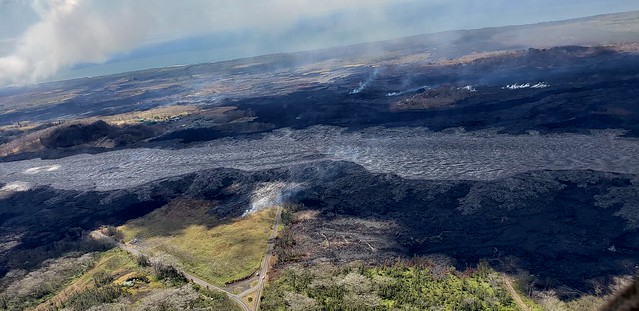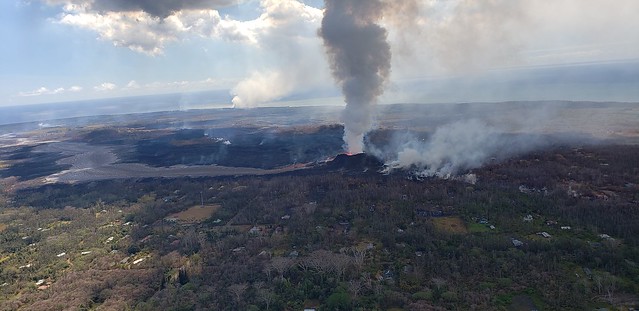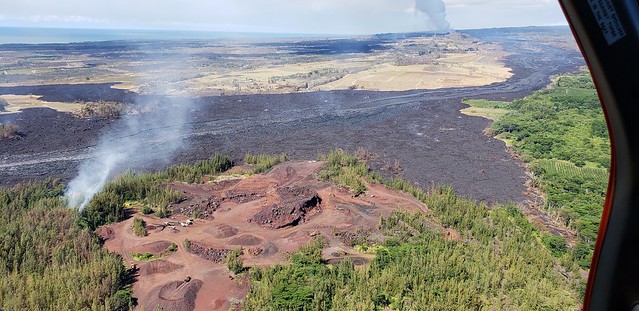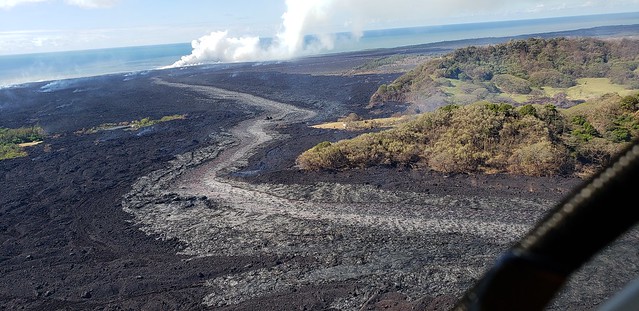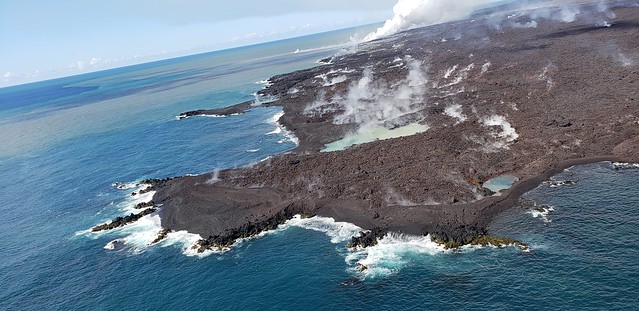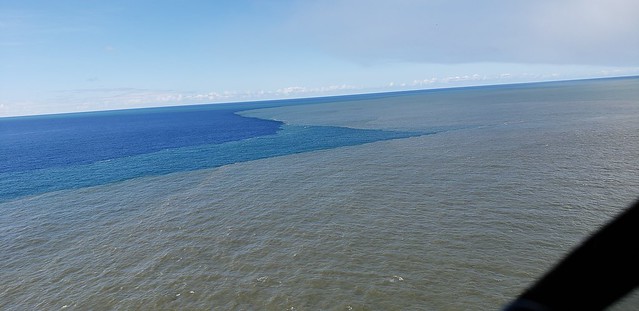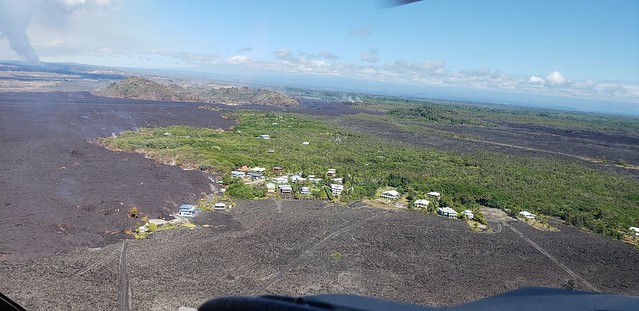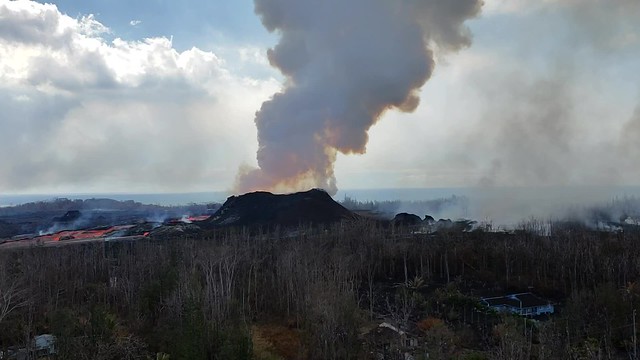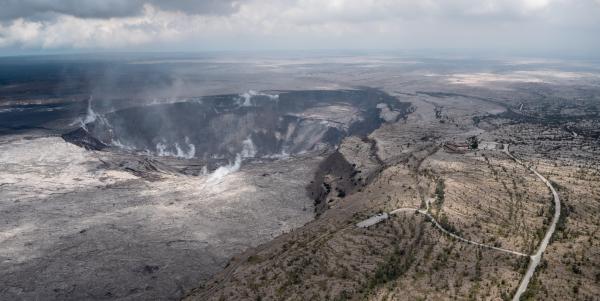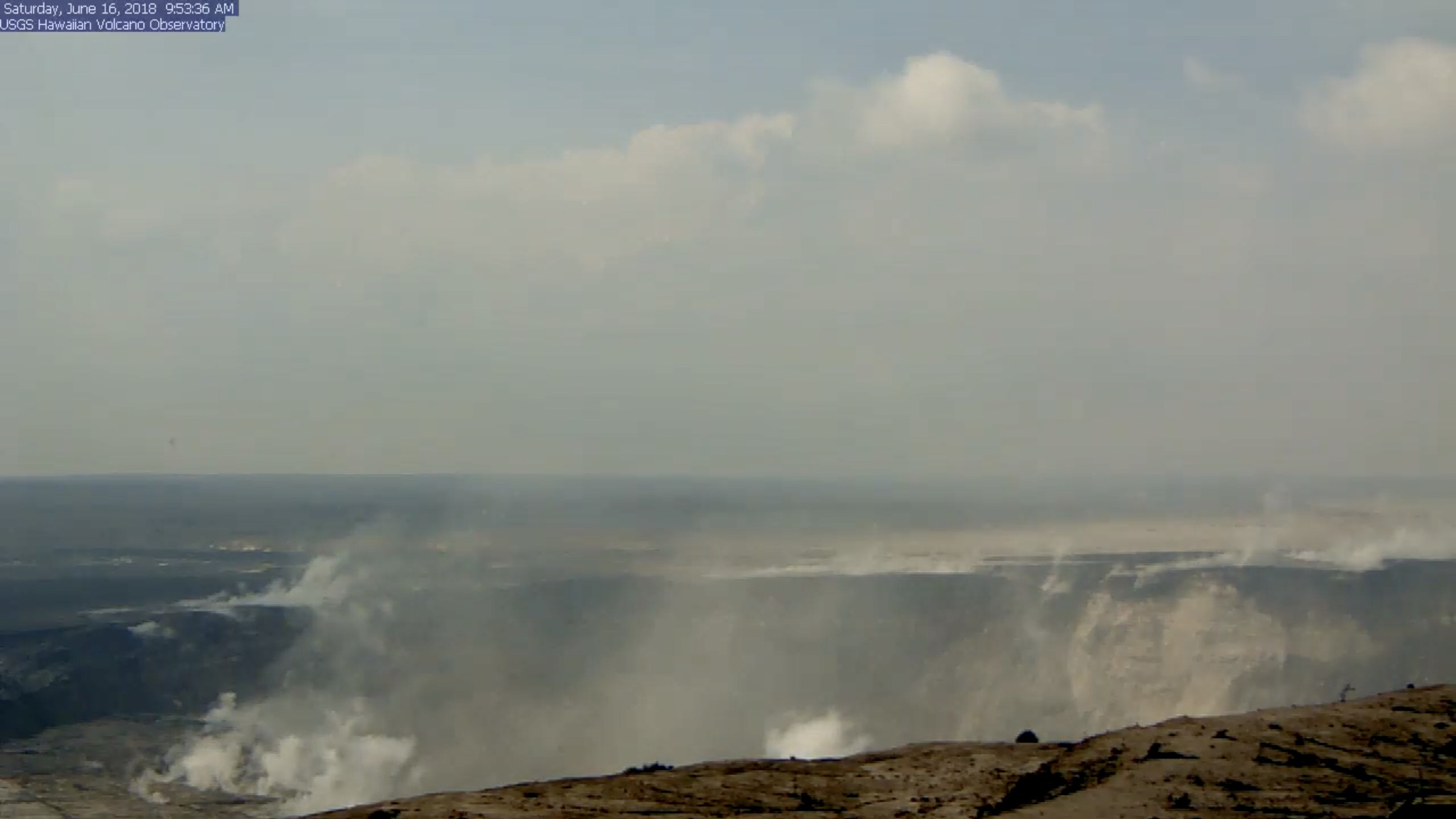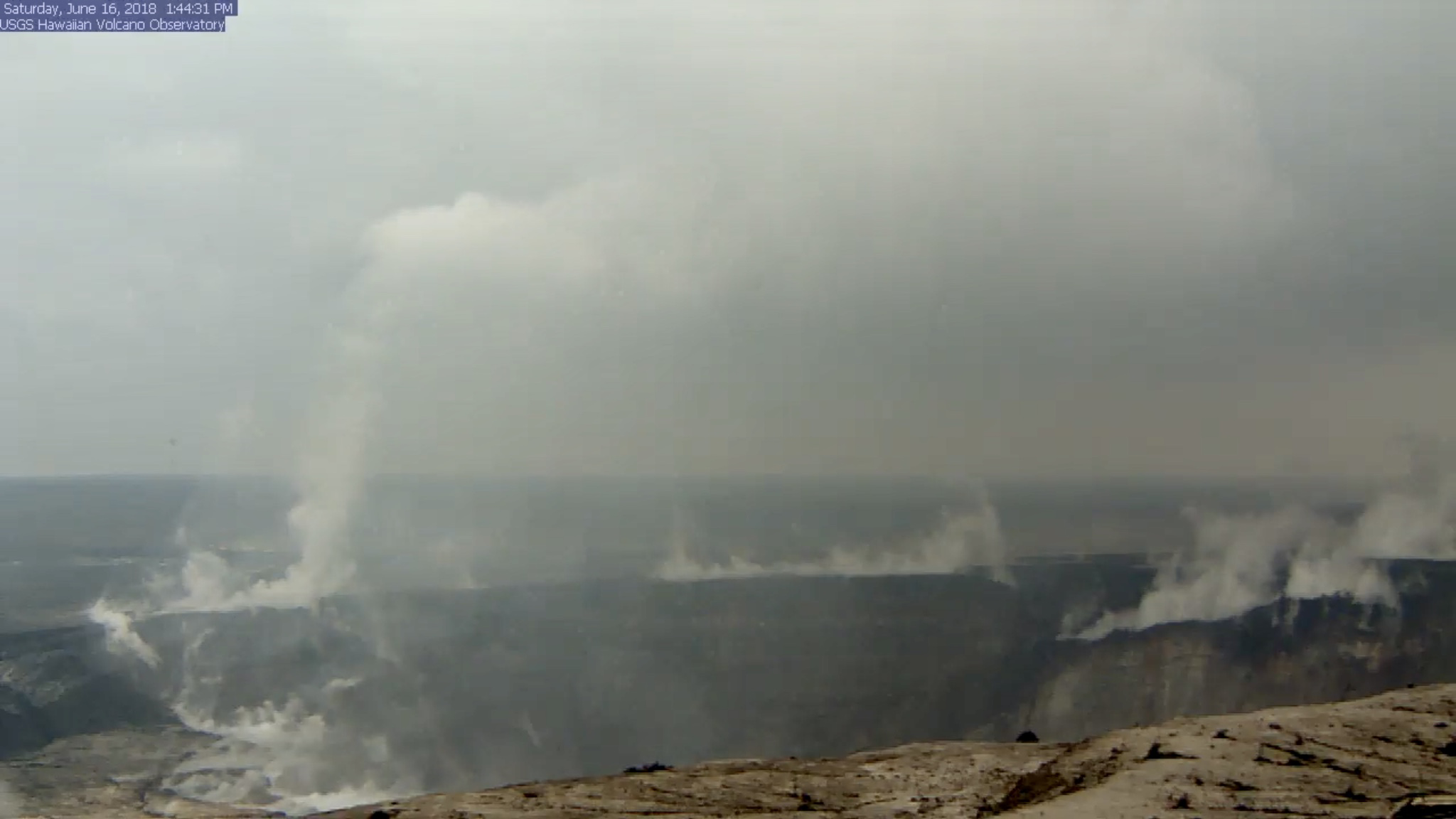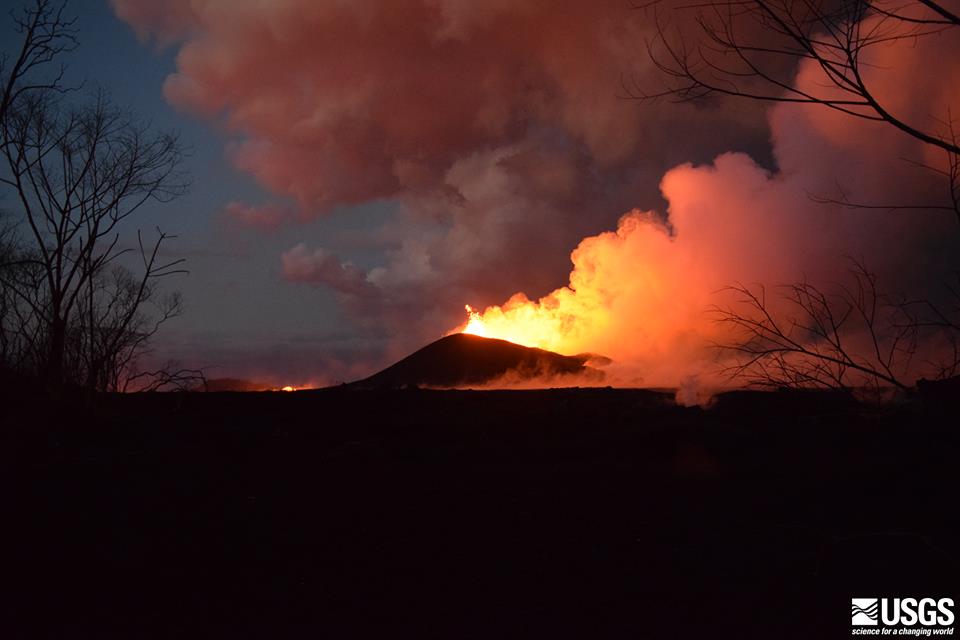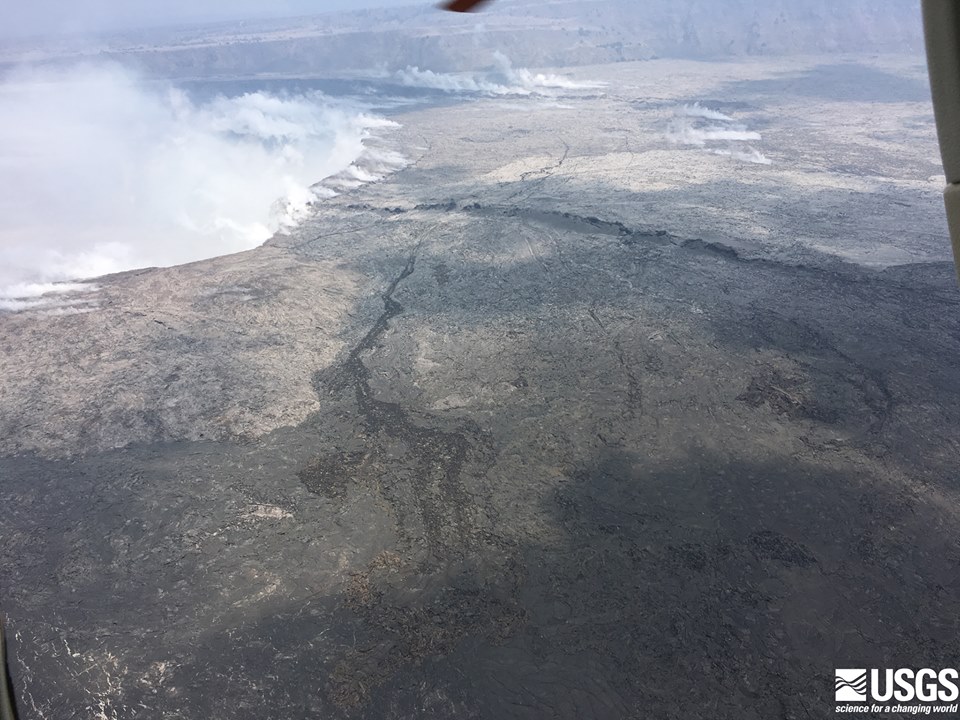Today’s Eruption Summary
Fissure 8 just keeps on going, as if it’s settling in for a Pu’u O’o eruption rather than a 1955/1960 eruption. Once again, there’s minor overflows upriver that don’t go anywhere. The ocean entry is mostly via the channel on the south side of the lava delta, but there’s also trickles along a kilometer-wide stretch of shore. Fissure 22 showed incandescence but no lava during the USGS morning overflight.
The USGS was skimpy on images today but gave us a treat: a timelapse of what they call “lava boats.”
Here’s their explanation: “Geologists captured this time-lapse video of the perched lava channel issuing from fissure 8 on Kīlauea’s lower East Rift Zone. Rafts of accreted lava move down stream and look like boats moving down a river. These are termed lava balls or lava boats and form when portions of the fissure 8 cone or levees break away and are rafted down stream. As they move along in the channel, additional lava can cool to their surface to form accretionary lava balls.”
After lots of minor earthquakes and rockfalls that sent up small plumes of dust, the daily summit “collapse explosion” occurred at 4:34pm. It sent up a 2000-foot plume, once again equivalent to 5.3 earthquake. Again, I couldn’t resist a video capture:
The runup to today’s explosion was impressive. There was one cascade of dust and rubble all the way around the walls that I would’ve taken for the day’s explosive event, except that there was no camera shake beforehand. Doubtless it was one of these:
Longest swarm of 3.0 & larger I've seen in the many years I've been getting notifications. 49 since 7 am Minor rockfall activity #earthquake #halemaumau #Hawaii #hvnp #hppa #volcano #Kilauea #lava #KilaueaVolcano #LeilaniEstates #BigIsland #eruption #Kapoho #火山 #噴火 #ハワイ pic.twitter.com/jeJKJkxey6
— lavapix.com (@lavapixcom) June 24, 2018
There’s not much news today, so let’s hitch a ride with the Hawaii County Fire Department and follow the lava river to the ocean. But first….

More on Lava Boats
I’d asked about the “lava boats” before that video was posted: “What’s forming those so-called “lava bergs”? Are they chunks off the sides of the levees? Do they indicate erosion/undermining of lava channel’s banks analogous to meanders of an H20 river, with risk of wearing through?”
@USGSVolcanoes offered some additional info in response: “They are chunks of the sides of levees as well as bits of the cone. As lava moves by them in the channel, they can be coated, dislodged, etc. Different than water – lava cools against cooler surfaces (channel sides) & we’ve started to see portions roofing over (forming tubes).” And when someone else asked if the whole 8 mile channel might become a lava tube: “It’s a possibility, but not necessarily guaranteed. It’s easier in places where the channel is already narrow.”
Which doesn’t answer my question about erosion/meanders, but looking back, they answered another question about braided lava channels on June 11 with this paper, which emphasizes that viscosity is a major factor in lava flows, whereas in H2O it’s particles in water.
Someone else’s Q on “lava boats”: ” Are these what’s floating beyond the ocean entry?
USGS: That’s a different process. The chunks floating beyond the ocean entry are bits of very bubble-rich lava-rock. When lava enters the sea there is sometimes an explosive process that expels rocks – the heat of the rock combined with the amount of bubbles causes these pieces to float for a while. Eventually, they cool, fill with water, and sink.
- Awkward place to stick this, but so I don’t forget: this week’s HVO “Volcano Watch” newsletter focused on “Mauna Loa Back to Normal.“
More USGS on Social Media
Q: What will happen if the summit collapse continues?
USGS: There are several options: It could enlarge #Halemaumau to a point and then the explosive activity could stop, or it could enlarge the crater and the explosions could change character.
Aha! It turns out the USGS posted photos today only on Facebook. Someday when things calm down, they need to comb their social media channels and make sure they’ve archived everything on the HVO website and/or USGS media library.

USGS image taken June 23, 2018, around 12:46 AM.” (Full-sized)

USGS image taken during the afternoon of June 22, 2018.” (Full-sized)

USGS image taken during the afternoon of June 22, 2018.” (Full-sized)
From Other Scientists
This #Sentinel2🇪🇺🛰 timelapse gives a good idea of the changes in the geography of the lava flows from #KilaueaEruption and clearly shows the #Kapoho bay being filled by lava@CopernicusEMS @caudronmartin @EUintheUS @CultureVolcan @USGSVolcanoes @Volcanoes_NPS pic.twitter.com/tHI70DHAco
— Copernicus EU (@CopernicusEU) June 23, 2018
Update: Lava from #KilaueaVolcano in #Hawaii observed by the latest #Sentinel2 imagery (22 June 2018)
1. Full imagery resolution of 10m
2. See the changes 10 days apart@CopernicusEMS @CopernicusEU @USGSVolcanoes#Kilauea #KilaueaErupts pic.twitter.com/kXpzOLfn7S— BigData Earth (@BigDataEarth) June 23, 2018
From Fissure 8 to the Sea with HCFD
If the USGS is too busy to post photos, the Hawai’i County Fire Department takes up the slack. (Unlike Facebook, Flickr is Google-able). Today Civil Defense shared their latest photo album, and once again I’m impressed by the definition of the camera they’re using compared to everybody else.
A small sample:
Looking southeast towards the “Y” junction at Pokoihi Rd, Kapoho Rd and 132 (Google Map) with Puna Geothermal Ventures in the background on the left:
Left and right, as different as night and day:
A disagreeable neighbor:
Looking towards the new lava delta:
Past the Lava Rooster house (near that mast):
Past the Cinder Pit:
Around Kapoho Crater (and former Green Lake):
To the sea. (Note upwelling.)
New land.
Effects extend offshore…
So far, so lucky. (Note the 1960 lava flow with roads on it.)
(warning: helicopter noise)
Sorry, got carried away. But there’s another 98 photos/videos in that album, including video all along the route and detailed views of houses, farms, even a dock.
From News Outlets
HNN is taking the weekend off; they’ve more than earned it. (Today they just altered a headline and called it a day: “637 homes destroyed by lava amid explosions, eruptions on the Big Island“) But KHON2 took up the slack:
- HTH: “Jaggar Museum’s fate uncertain as quakes take toll on facility overlooking growing Halema’uma’u”
- HSA: “Hula conference, chants to Pele coincide with the eruption“
- H247: “Volcano Watch: Kilauea Activity update for June 22, 2018″ features weekly timelapse vids for all the HVO webcams.
- HTH: “Third evacuation route being planned in case Highway 130 becomes impassable”
- HSA: “Charter school co-founder looks to future after eruption”
- HSA: “Closed voting sites and early absentee ballots raise concerns in Puna”
- HSA: “Unemployed on Big Island may qualify for disaster insurance”
- HSA: “Real estate loss from eruption approaches $400 million”
CD 6/22 6AM: #Fissure8 flow continues to feed lava to ocean. No immediate threat. Monitor gas, electricity & water connections after earthquakes in Volcano area. Free medical/dental today 8-5, Keaau HS. Today only, free legal clinic 9-2:30, Keaau HS. @USGS image #kilauea #puna pic.twitter.com/eRtgUsovue
— IG: @MalikaDudley (@MalikaDudley) June 23, 2018
Moment of Aloha
While we wait for daily explosions, the people living on Kilauea endure earthquake swarms, as Dispatches from Volcano describes today. Also, he waxes eloquent on the topic of naming Fissure 8.
STill More Photography/Videos
First up, Mick Kalber getting up close and personal with whatever it’s called. Good views of a spillover, Fissure 22 incandescence, and the red lava at the ocean entry. (Blog post on this overflight)
Here’s that spillover with streets labeled:
Fissure 8 and the lava channel today (6/23/2018) – a small channel overflow can be seen in this annotated image from @extremeexposure. #Kilauea #LeilaniEstates #KilaueaEruption pic.twitter.com/gHgFktx9lV
— Dane duPont (@GeoGolfHawaii) June 24, 2018
Other pros are still hitching rides with Paradise Helicopters and/or the National Guard:
This area which is now known as the “sulfur house” is an inactive fissure constantly venting SO2 just off of Moku St. in #LeilaniEstates. #KilaueaEruption #Hawaii #KilaueaVolcano pic.twitter.com/SMgas11iPz
— Anthony Quintano (@AnthonyQuintano) June 23, 2018
We've been documenting the laze by air, ground, and boat for weeks. #KilaueaEruption pic.twitter.com/9DdiFAh2sP
— the Weatherboy (@theWeatherboy) June 24, 2018
A lot of the landscape resembles a hell-like atmosphere. The stench of sulfur, the rumble of the lava boil, and death as far as the eye can see. It's both magical and extraordinarily sad. #KilaueaEruption pic.twitter.com/XWzQcbDX4u
— the Weatherboy (@theWeatherboy) June 24, 2018
Nice #rainbow and the #earthquakes continue as the east side contnues to collapse. #halemaumau #Hawaii #hvnp #hppa #volcano #Kilauea #lava #KilaueaVolcano #LeilaniEstates #BigIsland #eruption #Kapoho #火山 #噴火 #ハワイ pic.twitter.com/HjRuux5CrW
— lavapix.com (@lavapixcom) June 24, 2018
(East is left in the Kilauea livecam)
